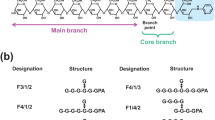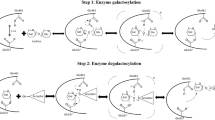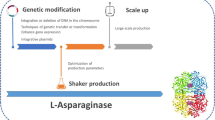Abstract
Bacterial unsaturated glucuronyl hydrolase (UGL) degrades unsaturated disaccharides generated from mammalian extracellular matrices, glycosaminoglycans, by polysaccharide lyases. Two Asp residues, Asp-115 and Asp-175 of Streptococcus agalactiae UGL (SagUGL), are completely conserved in other bacterial UGLs, one of which (Asp-175 of SagUGL) acts as a general acid and base catalyst. The other Asp (Asp-115 of SagUGL) also affects the enzyme activity, although its role in the enzyme reaction has not been well understood. Here, we show substitution of Asp-115 in SagUGL with Asn caused a conformational change in the active site. Tertiary structures of SagUGL mutants D115N and D115N/K370S with negligible enzyme activity were determined at 2.00 and 1.79 Å resolution, respectively, by X-ray crystallography. The side chain of Asn-115 is drastically shifted in both mutants owing to the interaction with several residues, including Asp-175, by formation of hydrogen bonds. This interaction between Asn-115 and Asp-175 probably prevents the mutants from triggering the enzyme reaction using Asp-175 as an acid catalyst.




Similar content being viewed by others
Abbreviations
- BacillusUGL:
-
Bacillus sp. strain GL1 UGL
- ClostridiumUGL:
-
Clostridium perfringens UGL
- C∆6S:
-
Unsaturated chondroitin disaccharide sulfated at the C-6 position of N-acetylgalactosamine residue
- GAG:
-
Glycosaminoglycan
- GH:
-
Glycoside hydrolase family
- PDB:
-
Protein Data Bank
- SagUGL:
-
Streptococcus agalactiae UGL
- UGL:
-
Unsaturated glucuronyl hydrolase
- WT:
-
Wild type
References
Ernst S, Langer R, Cooney CL, Sasisekharan R (1995) Enzymatic degradation of glycosaminoglycans. Crit Rev Biochem Mol Biol 30:387–444
Gandhi NS, Mancera RL (2008) The structure of glycosaminoglycans and their interactions with proteins. Chem Biol Drug Des 72:455–482
Imberty A, Lortat-Jacob H, Pérez S (2007) Structural view of glycosaminoglycan–protein interactions. Carbohydr Res 342:430–439
Sawitzky D (1996) Protein–glycosaminoglycan interactions: infectiological aspects. Med Microbiol Immunol 184:155–161
Lindahl G, Stålhammar-Carlemalm M, Areschoug T (2005) Surface proteins of Streptococcus agalactiae and related proteins in other bacterial pathogens. Clin Microbiol Rev 18:102–127
Koppe U, Suttorp N, Opitz B (2004) Recognition of Streptococcus pneumoniae by the innate immune system. Cell Microbiol 14:460–466
Mitchell TJ (2003) The pathogenesis of streptococcal infections: from tooth decay to meningitis. Nat Rev Microbiol 1:219–230
Marion C, Stewart JM, Tazi MF, Burnaugh AM, Linke CM, Woodiga SA, King SJ (2012) Streptococcus pneumoniae can utilize multiple sources of hyaluronic acid for growth. Infect Immun 80:1390–1398
Bidossi A, Mulas L, Decorosi F, Colomba L, Ricci S, Pozzi G, Deutscher J, Viti C, Oggioni MR (2012) A functional genomics approach to establish the complement of carbohydrate transporters in Streptococcus pneumoniae. PLoS One 7:e33320
Starr CR, Engleberg NC (2006) Role of hyaluronidase in subcutaneous spread and growth of group A streptococcus. Infect Immun 74:40–48
Rigden DJ, Jedrzejas MJ (2003) Structures of Streptococcus pneumoniae hyaluronate lyase in complex with chondroitin and chondroitin sulfate disaccharides. Insights into specificity and mechanism of action. J Biol Chem 278:50596–50606
Maruyama Y, Nakamichi Y, Itoh T, Mikami B, Hashimoto W, Murata K (2009) Substrate specificity of streptococcal unsaturated glucuronyl hydrolases for sulfated glycosaminoglycan. J Biol Chem 284:18059–18069
Nakamichi Y, Maruyama Y, Mikami B, Hashimoto W, Murata K (2011) Structural determinants in streptococcal unsaturated glucuronyl hydrolase for recognition of glycosaminoglycan sulfate groups. J Biol Chem 286:6262–6271
Nakamichi Y, Mikami B, Murata K, Hashimoto W (2014) Crystal structure of a bacterial unsaturated glucuronyl hydrolase with specificity for heparin. J Biol Chem 289:4787–4797
Kostyukova NN, Volkova MO, Ivanova VV, Kvetnaya AS (1995) A study of pathogenic factors of Streptococcus pneumoniae strains causing meningitis. FEMS Immunol Med Microbiol 10:133–137
Zwijnenburg PJ, van der Poll T, Florquin S, van Deventer SJ, Roord JJ, van Furth AM (2001) Experimental pneumococcal meningitis in mice: a model of intranasal infection. J Infect Dis 183:1143–1146
Hashimoto W, Kobayashi E, Nankai H, Sato N, Miya T, Kawai S, Murata K (1999) Unsaturated glucuronyl hydrolase of Bacillus sp. GL1: novel enzyme prerequisite for metabolism of unsaturated oligosaccharides produced by polysaccharide lyases. Arch Biochem Biophys 368:367–374
Cantarel BL, Coutinho PM, Rancurel C, Bernard T, Lombard V, Henrissat B (2009) The Carbohydrate-Active EnZymes database (CAZy): an expert resource for glycogenomics. Nucleic Acids Res 37:D233–D238
Itoh T, Akao S, Hashimoto W, Mikami B, Murata K (2004) Crystal structure of unsaturated glucuronyl hydrolase, responsible for the degradation of glycosaminoglycan, from Bacillus sp. GL1 at 1.8 Å resolution. J Biol Chem 279:31804–31812
Itoh T, Hashimoto W, Mikami B, Murata K (2006) Crystal structure of unsaturated glucuronyl hydrolase complexed with substrate. J Biol Chem 281:29807–29816
Jongkees SA, Withers SG (2011) Glycoside cleavage by a new mechanism in unsaturated glucuronyl hydrolases. J Am Chem Soc 133:19334–19337
Jongkees SA, Yoo H, Withers SG (2014) Mechanistic insights from substrate preference in unsaturated glucuronyl hydrolase. ChemBioChem 15:124–134
Jongkees SA, Yoo H, Withers SG (2014) Mechanistic investigations of unsaturated glucuronyl hydrolase from Clostridium perfringens. J Biol Chem 289:11385–11395
Itoh T, Hashimoto W, Mikami B, Murata K (2006) Substrate recognition by unsaturated glucuronyl hydrolase from Bacillus sp. GL1. Biochem Biophys Res Commun 344:253–262
Sanger F, Nicklen S, Coulson AR (1977) DNA sequencing with chain-terminating inhibitors. Proc Natl Acad Sci USA 74:5463–5467
Sambrook J, Fritsch EF, Maniatis T (1989) Molecular cloning: a laboratory manual, 2nd edn. Cold Spring Harbor Laboratory Press, Cold Spring Harbor
Otwinowski Z, Minor W (1997) Processing of X-ray diffraction data collected in oscillation mode. Methods Enzymol 276:307–326
Vagin AA, Isupov MN (2001) Spherically averaged phased translation function and its application to the search for molecules and fragments in electron-density maps. Acta Crystallogr D Biol Crystallogr 57:1451–1456
Winn MD, Ballard CC, Cowtan KD, Dodson EJ, Emsley P, Evans PR, Keegan RM, Krissinel EB, Leslie AGW, McCoy A, McNicholas SJ, Murshudov GN, Pannu NS, Potterton EA, Powell HR, Read RJ, Vagin A, Wilson KS (2011) Overview of the CCP4 suite and current developments. Acta Crystallogr D Biol Crystallogr 67:235–242
Murshudov GN, Vagin AA, Dodson EJ (1997) Refinement of macromolecular structures by the maximum-likelihood method. Acta Crystallogr D Biol Crystallogr 53:240–255
Afonine PV, Grosse-Kunstleve RW, Adams PD (2005) The Phenix refinement framework. CCP4 Newsl 42:8–9
Adams PD, Afonine PV, Bunkóczi G, Chen VB, Davis IW, Echols N, Headd JJ, Hung LW, Kapral GJ, Grosse-Kunstleve RW, McCoy AJ, Moriarty NW, Oeffner R, Read RJ, Richardson DC, Richardson JS, Terwilliger TC, Zwart PH (2010) PHENIX: a comprehensive Python-based system for macromolecular structure solution. Acta Crystallogr D Biol Crystallogr 66:213–221
Emsley P, Lohkamp B, Scott WG, Cowtan K (2010) Features and development of Coot. Acta Crystallogr D Biol Crystallogr 66:486–501
Laskowski RA, Macarthur MW, Moss DS, Thornton JM (1993) PROCHECK—a program to check the stereochemical quality of protein structures. J Appl Crystallogr 26:283–291
Kabsch W (1976) Solution for best rotation to relate two sets of vectors. Acta Crystallogr Sect A 32:922–923
Acknowledgments
We thank Drs. S. Baba and N. Mizuno of the Japan Synchrotron Radiation Research Institute (JASRI) for kind help in data collection. Diffraction data for crystals were collected at the BL-38B1 station of SPring-8 (Hyogo, Japan) with the approval of JASRI (Projects 2009A1179, 2010B1149, 2011A1186, 2011B2055, and 2013B1260). We also thank Mss. C. Tokunaga and A. Matsunami for excellent technical assistance. This work was supported in part by Grants-in-Aid from Japan Society for the Promotion of Science (to K. M. and W. H.), a Research Grant (to W.H.) from Mizutani Foundation for Glycoscience, and a research fellowship from Japan Society for the Promotion of Science for Young Scientists (to Y. N.).
Author information
Authors and Affiliations
Corresponding author
Ethics declarations
Conflict of interest
None.
Rights and permissions
About this article
Cite this article
Nakamichi, Y., Oiki, S., Mikami, B. et al. Conformational Change in the Active Site of Streptococcal Unsaturated Glucuronyl Hydrolase Through Site-Directed Mutagenesis at Asp-115. Protein J 35, 300–309 (2016). https://doi.org/10.1007/s10930-016-9673-y
Published:
Issue Date:
DOI: https://doi.org/10.1007/s10930-016-9673-y




